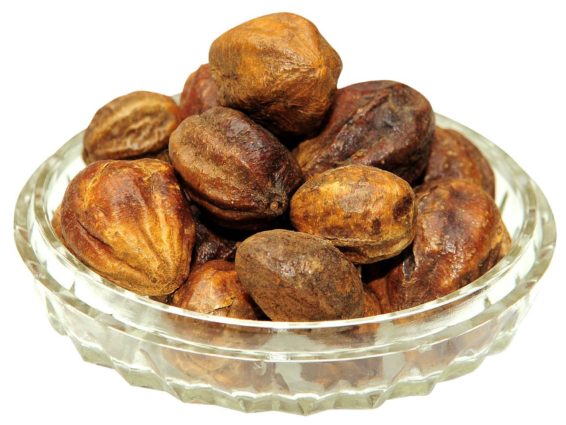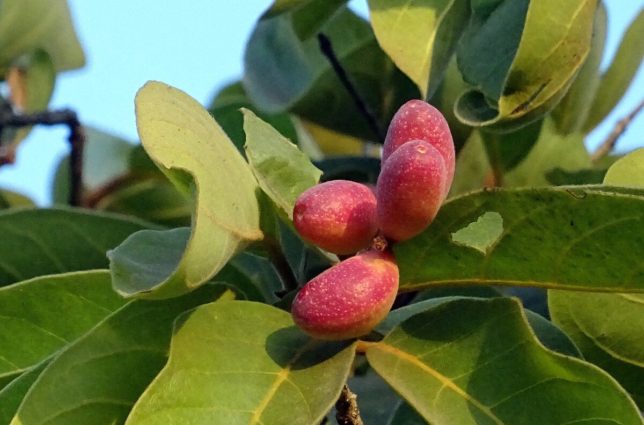Haritaki (terminalia chebula)
Haritaki, myrobalan chebula, terminalia chebula (Latin), chebulic myrobalan, black myrobalan, myrobalan chebula ( English), haritaki, Hara, Harad, hirad, halle, kayastha, jivapriya, harida, abhaya, harde, Harad (Indian)
Haritaki “literally means” a plant that steals diseases”. In the Ayurvedic canons, it is said that Haritaki can cure a hundred ailments. In the Madana-pala-nighantu, Haritaki is compared to a mother: “Just as a mother takes care of a child, so Haritaki takes care of a person. But the mother is sometimes angry, and Haritaki will never harm anyone who accepts her…” In Ayurvedic and Tibetan medical treatises, you can find many legends about the origin of Haritaki. It is believed that the seven types of Haritaka are the seven drops of nectar that fell to the Ground from the mouth of Vishnu (the Supreme). Another text says that the Haritaka forest grew up on the site of the love games of Varuna (the water god) and Bhumi (the Earth Goddess).
Effect on the body
Although all parts of the plant have a healing effect (roots eliminate diseases of the bones, trunk-muscles, bark-skin, branches-vessels, leaves-hollow organs), Ayurvedic doctors use mainly the fruits of the plant, as they normalize the function of the neuroendocrine system and all vital organs. It subsides all tridosha: Vata, Pitta, and Kapha.
The energy-informational matrix of plant fruits is similar to the human etheric body and the energy-informational field of the Earth. This means that Haritaki has a tuning fork effect on the sthula and sukshma channels of a person, which are responsible for the state of homeostasis (constancy of the internal environment of the body). Each of these channels contains encoded information about how certain tissues, hormones, enzymes, and other biologically active substances should function. These subtle channels of man are connected with each other by special centers of the etheric body, called marmas. Marmas regulate the functions of all vital organs through the neuroendocrine system.
Since we are currently under the constant influence of lepton radiation, the sources of which are high-voltage transmission lines, mobile phones, computers, televisions, microwave ovens, and other industrial and household electronic equipment, the etheric matrix of a person with all its centers and channels are greatly changed, which leads to a violation of homeostasis. Such deviations are dangerous for the development of serious chronic diseases. It should be added that the distortion of the work of our tuning fork system also occurs if a person’s consciousness is filled with various negative stereotypes, such as greed, hatred, envy, condemnation, fear, pride, and the like. Haritaka fruits are able to read the missing information from the Earth matrix and transfer it to the human field structure, restoring the function of all marma centers.
The most powerful antioxidants belonging to the group of anthocyanidins are found in the fruits of haritaki, which, due to the neutralization of free radicals, stop damage to the endothelium of the arteries, the occurrence of cross-linking of collagen protein, the suppression of cellular immunity, including antitumor, violations of the colloidal balance of bile and urine. Thus, haritaki is a wonderful preventive tool that prevents the development of atherosclerosis, cancer, autoimmune diseases, degenerative-dystrophic disorders of the spine and joints, urolithiasis, and cholelithiasis.
Due to the high content of hebulic acid, haritaki fruits stimulate the activity of cytochrome 450 enzymes responsible for the antitoxic function of the liver. It is also believed that the plant is able to activate the antitoxic function of all cells. In addition, hebulic acid, penetrating through the blood-brain barrier, normalizes the state of the cells of the brain and spinal cord. A person who regularly takes the fruits of the plant increases the threshold of adaptation to external damaging influences, strengthens memory, and improves learning abilities. In the case of the destruction of myelin fibers (multiple and amyotrophic sclerosis), haritaki stimulates their regeneration.
In addition, due to its pronounced astringent action, haritaki is also used as a hemostatic agent, especially as prevention of uterine bleeding in fibromyomas.
The fruits of haritaka directly activate the small intestine’s apudic cells, thus influencing hormonal metabolism.
Indications for use
- Cough
- Asthma
- Hoarseness of voice
- Hiccups
- Vomiting
- Hemorrhoids
- Diarrhea
- Poor digestion of food
- Bloating
- Parasitic infections
- Tumors Jaundice
- Diseases of the spleen and heart
- Skin diseases
- Itching
- Edema
- Nervous disorders
Contraindications
Pregnancy, dehydration, severe exhaustion or exhaustion, very high Pitta.
Dosage
1 capsule twice a day 1 hour after meals.
Additional information
Haritaki — a powerful antioxidant, Rasayana, rejuvenates, cleanses the body of toxins and toxins. Haritaki restores the energy field, treats diseases of the lungs and digestive system. Haritaki is a mild laxative. Haritaki improves vision, memory, blood circulation, immunity, stops bleeding, lowers cholesterol. Haritaki has carminative, anthelmintic, anti-inflammatory, antiseptic, antifungal, astringent properties. Haritaki is an effective remedy for premature hair graying and hair loss, stimulating their growth.
Methods of application
Haritaki is taken 1-2 capsules twice a day: in the morning an hour before breakfast and in the evening two hours after dinner. The minimum duration of the therapeutic course is 2 months.
“Haritaki” literally translates as “eliminating diseases“. “Hara” is another name of Shiva, which indicates the sacred nature and outstanding position of haritaka among other plants, as it carries the energy of Shiva himself. In addition, “hara” also literally means “green”, i.e. green, like a fruit. “Abhaya” means “fearless”, i.e. not afraid of any diseases. Hippocrates claimed that regular consumption of haritaka and its juice after meals prevents any diseases.
The medicinal properties of haritaka are used in the following cases:
– as a general tonic, antioxidant and anti-aging agent for the whole body, strengthens the immune system, normalizes the activity of the whole body, eliminates disorders in its work, improves the perception of all five senses
– to improve brain function, strengthen memory, increase learning ability, intelligence
– for toning the nervous system, for nervous disorders, relieves fatigue, stress, depression
– to cleanse the body of toxins and slags
– for fever, fever, asthma, tuberculosis, cough, hoarseness of the voice, as an expectorant, improves the voice (often taken with pipali)
Removes accumulated mucus, and the accumulated and activated cotton rushes through the channels and treats asthma and other diseases, has a beneficial effect on the vocal cords.
– for digestive disorders, to improve digestion and assimilation of food, it excites the appetite (often taken together with cardamom and dill)
– as a mild laxative, regulates bowel function, helps maintain regular stools, and guarantees smooth cleansing, depending on the dosage helps with both constipation and diarrhea (often taken with pipali, amla and bibhitaki)
The sinosides contained in haritaki treat constipation, the tannins treat diarrhea. In the first case, a large dose of the plant is taken, in the second – a small one.
This dual-action of haritaka-laxative and astringent illustrates the versatile nature of this amazing fruit. Haritaki decoction has a more astringent effect, as tannins dissolve in water, while haritaki powder gives a greater laxative effect.
– for intestinal infections, such as anthelmintic
– for stomach diseases, bloating, as a carminative, for hemorrhoids
– to improve blood circulation and strengthen blood vessels
— as an antitumor agent and as a cancer prevention agent
– hepatitis, normalizes liver function, due to the high content of hebulic acid, which removes toxins from the liver
– with cholelithiasis
Haritaki juice and amla, taken regularly after meals, can completely dissolve gallstones.
– for fimbromiomas and uterine bleeding
– to improve vision, gives sharpness of vision, conjunctivitis, inflammation, helps with blindness (often taken together with amla)
– as a remedy that heals and tightens ulcers of the mucous membranes, due to its strong astringent properties
– as a means to maintain optimal weight (often taken together with ashwagandha)
Helps to neutralize heavy and fatty foods, it is recommended to take people who are in the habit of overeating.
– to reduce cholesterol in the blood (often taken with honey)
– for gargling (usually with cold water to enhance the astringent properties), eliminates bacteria, germs, heals wounds and ulcers
– for the treatment of skin diseases, fungal infections
– as an excellent preventive tool that prevents many diseases
– as an aphrodisiac, tones the uterus, eliminates many sexual infections
– as a hemostatic agent
– for diseases of the heart and spleen
– with high acidity
– to reduce high blood pressure
– to strengthen the gums, stops bleeding
– vomiting, nausea, hiccups
– for hemorrhoids
It is not recommended to take Haritaki during pregnancy, as the laxative properties and downward-pointing Vata can provoke an abortion, with exacerbations of Pitta, acute diarrhea, and a strong cough.
As a Rasayana, haritaki is used independently and is also included in many Ayurvedic tonics and mixed Rasayanas. Haritaki is one of the main components of the famous “Chavanprash” and the cleansing drug “Triphala” (a mixture of amla, haritaki, bibhitaki powders).
According to Ayurveda, haritaki should be taken with mountain salt or ginger in the rainy season, with sugar in the fall, in the spring with honey, in the winter with pepper. It should be taken with sugar for the Pitta dosha, with salt for the Vata dosha, and with dry ginger for the Kapha dosha.
Haritaki is used internally in the form of powder, capsules, juice, decoction, jam, externally-in the form of infusions and pastes. It is part of therapeutic lotions, creams, and ointments.

Haritaki is widely used in cosmetology and is part of many cosmetic products – in face and body creams, facial cleansers, masks, milk, gels, and anti-aging cosmetics complexes. However, haritaki is primarily used in hair care and hair treatment products.
Haritaki is used in cosmetology due to:
– antioxidant and anti-aging properties
Removes toxins from cells, neutralizes free radicals, and stops damage to collagen fibers. Improves blood circulation, complexion, smoothes wrinkles, eliminates puffiness, nourishes, tones and rejuvenates the skin.
Suitable for all skin types, it is most recommended for the care of mature skin, as well as fading, tired, flabby, aging skin.
– antiseptic and antibacterial properties
Deeply cleanses the pores and removes dirt, gives antiseptic protection to the skin. Strong antifungal and antibacterial agent. Effectively helps with skin rashes.
– astringent, wound-healing properties
Promotes rapid tightening and healing of ulcers and wounds, stops bleeding.
Haritaki is one of the main products in Ayurvedic cosmetology for hair treatment and hair care. It is a part of numerous hair products – shampoos, masks, conditioners, rinses, balms, oils, creams and hair dyes. Haritaki extracts and oil are used.
Haritaki oil is included in the composition of hair oil as one of the main ingredients and is also used in its pure form. It is the main component of the “Triphala” or “Triphaladi” hair oil, which also includes amla and bibhitaki.
It stimulates cell regeneration, improves blood circulation, provides blood flow and nutrients to the bulbs, and stimulates hair growth. It helps to reactivate non-living hair, prevents premature gray hair, and is an effective remedy for hair loss. Eliminates dandruff. Gives radiance and shine, vitality and strength.
It is part of the therapeutic agents against hair loss and dandruff.
Suitable for all hair types and for everyday hair care.
Restores lifeless, dry, brittle, thinned hair, hair that has been exposed to adverse environmental influences, coloring, after an illness.
Supports the health of normal hair, gives them antiseptic protection.
Haritaki-Rasayana, the elixir of youth, the strongest antioxidant, has a rejuvenating effect, cleanses the body, and is part of many Ayurvedic Rasayanas. Activates the body’s defenses and promotes longevity. Haritaki is called the “elixir of longevity”.
In addition, Haritaki is one of the best remedies in Ayurveda for treating problems related to the lungs and digestive system. It is widely used in Ayurvedic and Tibetan medicine, where it is called the “king of all medicines”.
Haritaki has the most powerful energy, destroys all negative programs that appear in the body, evens out the distorted energy field, neutralizes harmful effects. It gives the energy of pure knowledge. Haritaki increases the threshold of adaptation to external influences. Haritaki is one of the few plants that treat on a subtle level, correcting and restoring the human biofield.
According to Ayurveda, haritaki has all the flavors of the six possible, except salty: sour, astringent, sweet, bitter, spicy. It has a very strong astringent taste but leaves a sweet aftertaste. It has a warming effect.
Haritaki normalizes the functioning of the entire body, acts on all tissues, regulates Kapha-dosha, stimulates pitta-dosha, but especially favorably affects Vata-dosha (reduces the accumulation and stagnation of Vata).
Haritaki contains an antioxidant complex of tannins-galic, hebulic and tannic acids, as well as catechins.
All parts of the tree (bark, leaves, flowers) have healing properties, but most of all haritaka fruits are used.
There are 7 types of haritaka-vijaya, rohini, putana, amrita, abhaya, jivanti and chetaka-native to various parts of India. Vijaya grows in the Vindhaya Mountains, rohini in Northern India, putana in Southern Pakistan, Amrita and abhaya in Eastern India, jivanti in Gujarat, and Chetaki in the Himalayas.
Vijaya is considered the best in its properties, affecting all the tissues of the body. It has the roundest shape. Rohini heals the wounds. Putana is used for skin diseases in the form of a paste. Amrita is a wonderful purifier. Abhaya is especially effective for eye diseases. Jivanti cures many diseases, chitaki has a pronounced laxative effect.
Haritaki has antioxidant, anti-aging, tonic, carminative, antiseptic, antifungal, antibacterial, anti-inflammatory, expectorant, anthelmintic, astringent, hemostatic properties.
Unripe haritaka fruits have a stronger laxative effect, but less anti-aging properties.
Haritaki-an evergreen flowering tree from the family Combretaceae, belongs to one of the myrobalans-a group of plants growing in the Himalayas, known for their antioxidant, rejuvenating properties and having fruits similar to plums or acorns (Greek. Myron-incense oil, balanos-acorn). The main myrobalans are haritaki, bibhitaki and amla.
Homeland-India, as well as the adjacent areas of Nepal, south-western China, Sri Lanka. It is a tall, large tree, reaching 20 m in height, with a large trunk, brownish-gray bark, leathery leaves, yellow flowers, hard and strong wood, and small oval fruits of a color similar to a nut or acorn.
Haritaki is one of the most famous plants in Ayurveda, which is included in the” golden row ” of Ayurveda and is revered throughout India.
According to one of the myths, haritaki was born from a drop of amrita, the elixir of immortality, which fell from heaven to earth. The God Indra admired the dance of the apsaras, the celestial dancers who aroused his passion and poured Amrita on the earth. From the spilled drops grew haritaki, which has divine energy and a warming effect caused by the passion of Indra. The haritaka fruit is held in the hand of the Healing Buddha.
Haritaki (terminalia chebula)
The material is prepared by specialists for informational purposes only. It should not be used as a guide for the treatment of diseases, and it cannot replace professional medical advice, diagnosis, or treatment. In case of illness or any symptoms, you should not self-medicate and should always consult a doctor.



